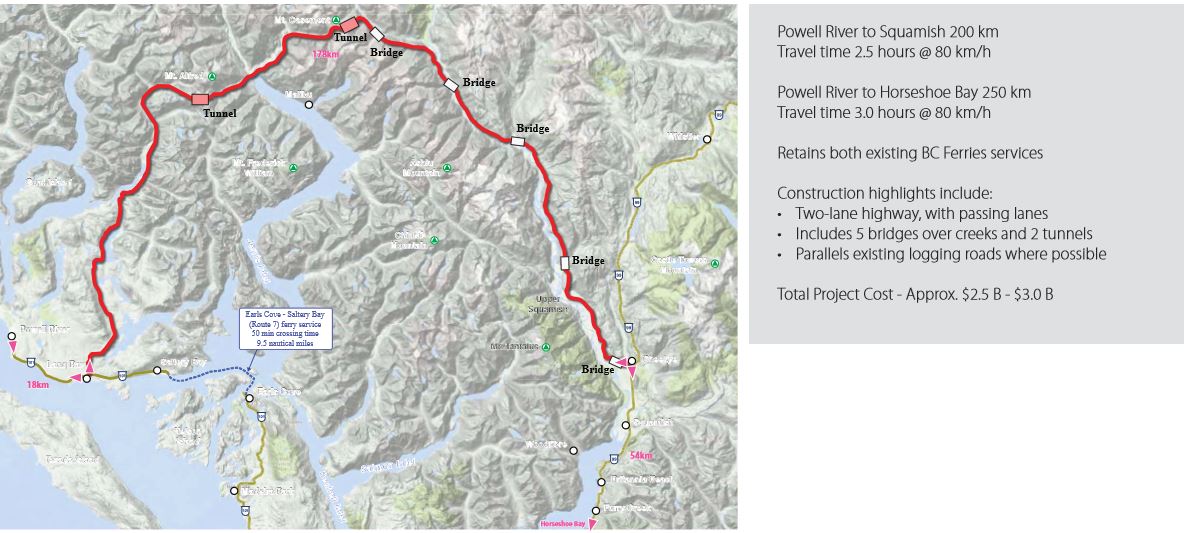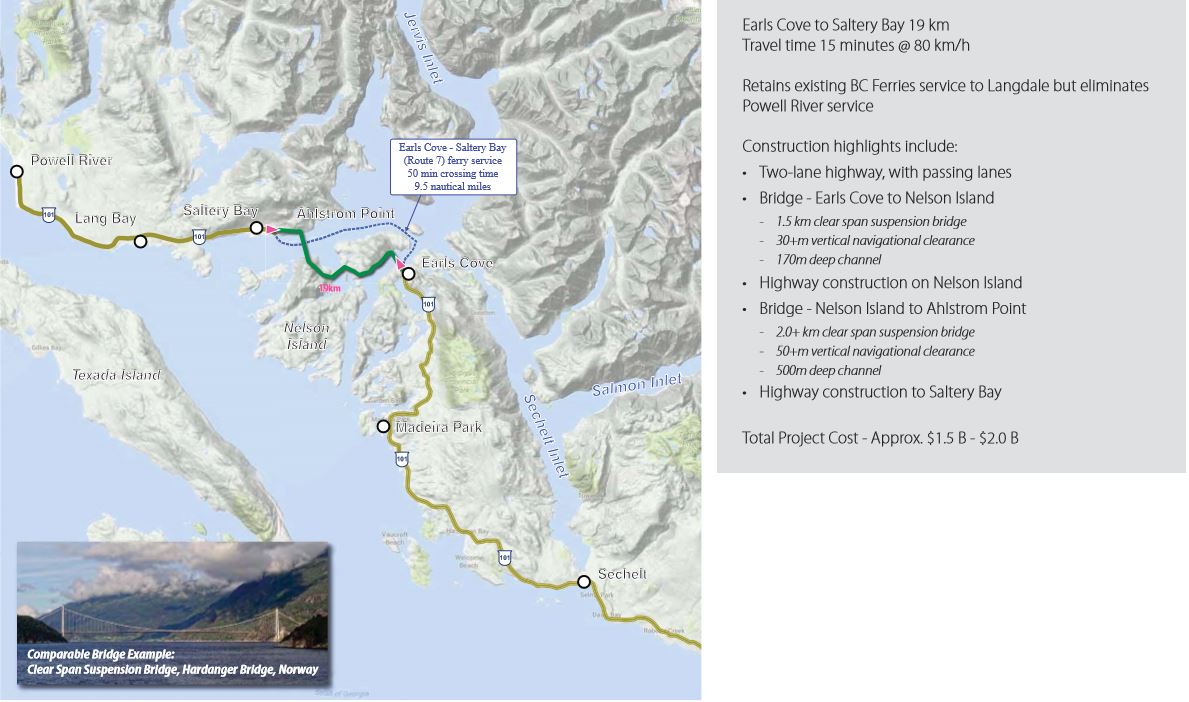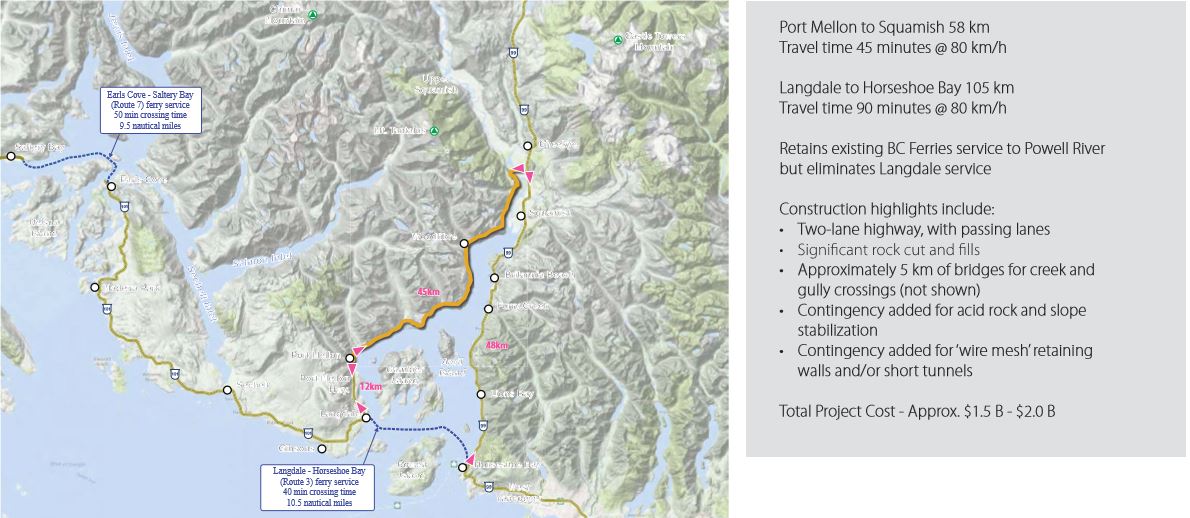John Whistler provides background and comment on yet another massive road-and-bridge project proposed by the Province.
Sunshine Coast Fixed Link Options
After reviewing the various fixed link options, the first impression is the extreme costs and engineering challenges. This explains why a link over Bowen and Keats Islands did not even make the long listing of 13 options that were initially identified.
There is now a short listing of five options:
Powell River Road Link – Estimated $2.5 – 3 Billion.
This is a new 200-km highway from Squamish to Powell River, over Jervis Inlet, including five bridges and two tunnels. Surprisingly, this option anticipates that the existing BC Ferries services would be retained. It seems the only significant benefit might be resource development that would be opened up. However this is unlikely given unsettled First Nations land claims.

Powell River Bridge Link – Estimated $1.5–2 Billion.
This would replace the Earls Cove to Saltery Bay ferry service with a 1.5 km suspension bridge from Earls Cove to Nelson Island and a 2 km suspension bridge from Nelson Island to Ahlstrom Point along with interconnecting highways.

Langdale Road Link – Estimated $1.5–2 Billion.
This is a new 58-km highway from Squamish to Port Mellon that would hug the west side of Howe Sound – 105 km from Langdale to Horseshoe Bay. Basically, this would be a mirror image of the east-side Hwy 99, which was a significant engineering accomplishment when it was built in the 1950s. This route would also be subject to the landslide and traffic safety risks that currently exist on Hwy 99.

Langdale Bridge Link – Estimated $2–2.5 Billion.
This would have a 1.5 km suspension bridge from Hwy 99 near Brunswick Point to Anvil Island and another 1.5 km suspension bridge to near McNab Creek, and then a new highway to Port Mellon – 50 km from Langdale to Horseshoe Bay. Is this option worth the extra billion or so in costs to save 55 km of driving?

Maintain existing ferry services – Status Quo.
In 2015, the BC Ferries Annual Report notes the Horseshoe Bay-to-Langdale route required a subsidy of $2,980,000, and the Earls Cove to Saltery Bay route made a profit of $2,128,000.
The BC Ministry of Transportation Infrastructure background material includes a Multiple Account Evaluation (MAE) of the various short-listed scenarios with a high-level review of the economic, environmental, social and service implications. Unfortunately the status quo option was not included in the comparison table in the MoTI posting.
As such it is confusing for the reader to determine which option is better. However, based on cost only, the status quo with the existing ferry services is compelling.













So for $4-5 billion we get car oriented options to service 30,000 people who live there, which must include upgrades to the existing highway as well. And then, of course, the increase in tourist and local traffic just might have an effect on the three lane 1938 Lions Gate Bridge and the 1960’s Ironworkers Bridge that have lots of space for extra cars to connect with Vancouver…Or of course, we might spend a smidgeon of that amount to have a commuter rail service with DMU’s on the provincially owned rail right of way up to Chilliwack that might service the million or so people on the south side of the Fraser.
A quick tally . . . . . .
Proposed highways with Squamish-Langdale Road:
Low: $5.5B. High: $7.0B
With Langdale Bridge:
Low: $6.0B. High: $7.5B
Total: $5.5B – $7.5B
***
Ferries:
Horseshoe Bay – Langdale: $2,980,000 (cost)
Earl’s Cove – Saltery Bay: $2,128,000 (profit)
Balance: $852,000 (cost)
***
Q: With the lowest road / bridge estimate 6,500 times greater than the net ferry subsidy, doesn’t it make more economic sense to improve and diversify ferry service?
The total cost of existing and proposed highway / bridge projects that connect directly to the Metro from Port Mann / South Fraser / Hwy 1, through Massey, and now through to Powell River, will probably exceed 17 billion bucks, not including financing and perpetual operating costs.
Meanwhile, far more efficient public transit in the city that accommodates over half the provincial population, and affordable ferry service to many coastal communities have been anemically funded or outright cut back at levels only a small fraction of the above costs.
Is this not the definition of economic insanity and a gross waste of public money?
Opening up new frontiers costs money, lots of it.
It does seem high though.
Not counted are the numerous benefits for cities and province such as increased tax revenue from land transfer taxes, higher property taxes on higher property values and PST, individual & corporate income taxes on new construction, new schools, new stores, more tourism, hotels etc
Amortizing a $1B over 100 years at 2% interest is $23M/year, small compared to the annual benefits. At $3-4B of course it may not make sense.
Not mentioned are faster passenger only ferries that would help boost Gibsons and Sechelt area too at a fraction of the cost.
Meanwhile, Canada is targetting 100,000,000 people by 2100, which requires over 400,000 new people annually. That does require new infrastructure to expand Lower Mainland. http://www.theglobeandmail.com/opinion/increasing-immigration-wont-fix-canadas-growth-challenge/article32463961/
One key paragraph from that piece on immigration …..
The problem with an aging baby-boomer generation is not that Canada needs more people. The number of people isn’t the issue; the proportion in the workforce is. Immigration can only have the desired impact on economic growth if the majority of newcomers are young workers, rather than dependents or retirees. […]
Most immigrants have kids. And they in turn have kids, and so forth. The author needs to examine the long-term economic growth brought forth by generations of immigrants over time. I’ve said before that the progeny from both sets of my grandparents, all four of whom were immigrants who arrived between 1902 and 1921, now number in excess of 400 people who are all taxpayers and participants in the economy to various degrees. Tally up their total lifetime economic contribution and it’s hundreds of millions and growing.
I also note that not one of the employees at my mother’s care facility were NOT immigrants, with the exception of management (what a telling sign that was!). The immigrants accepted the lower paying but vital jobs Canadians wouldn’t. However, their children are 100% Canadian and will be the ones with a higher education and ability to move up on the economic ladder.
We are all children of immigrants with few exceptions, Thomas.
I am an immigrant too. I think we have too high an immigration into Canada and what defines Canada is more and more unclear to me. Anything goes. Any value. Any dress. Any religion. What does it mean to be “Canadian” with 400,000+ immigrants a year. Not my preference.
When you look at interest rates over the last 100 years, I really don’t think you can project an amortization rate of 2% for the next hundred. The world’s total level of debt is stratospheric, and the world economy is propped up by the laws of physics with certain absolute limits with respect to energy. Then there is greed and speculation in some jurisdictions with not enough regulation against it.
The economy may not even exist in its current form in 100 years.
Well, I suppose it should be pointed out that with a toll, the fixed link would pay for itself eventually. Most people didn’t mind forking over 10 bucks to drive the Coquihalla after it was built, so they probably would mind forking over 20 bucks to drive the Sunshine Coast Fixed Link after it was built. The Langdale Bridge Link would, I think, have a fairly major impact on the way of life up there as it is the shortest route, so it would create a fairly major impetus for developers to build commuter subdivisions in that area. The Langdale Road Link would be better in that it is a longer route and so would reduce the rationale for building commuter subdivisions up there, and it is also cheaper than the Langdale Bridge Route. My favourite is the Powell River Road Link, but it’s probably the least likely to be built because it is the most expensive, and because it wouldn’t provide a fixed link lower Sunshine Coast (other than reduce the ferry traffic).
Tolls recover only the basic construction cost. There is no cost recovery for the ongoing operating costs of roads (maintenance, depreciation, replacement, interest, etc.). That is covered by the annual tax draw and debt.
If the Langdale link is only going to be 2.5 billion for both bridges (both with very long spans over what I assume is deep water) I will be shocked, look for final costs on that option to be 4 billion or higher unless technology changes.
You bet.
Construction overruns are common, and preliminary estimates are anything from pretty accurate except for contingencies to sheer fantasy.
I think only the shipping lane side would be a big issue. The other side could be a floating bridge. Two or four lanes would suffice.
A 2km span however would be record breaking in length, so I agree with your assessment. A hefty toll would still be likely to recover the cost of any bridges after development is spurred.
I’d prefer the Whytecliff-Bowen-Gibsons double hop compared to the other options though. I’d imagine this is a non-starter with the Bowen crowd though. The span would be similar though, 2km.
The biggest problem with these bridge options is the fact that fjords are really deep. A suspension bridge pylon anywhere offshore would have to be built as deep below water as it is tall above water. So, the main spans are as you said 2km+ long. The pylons would subsequently be near 1,000′ tall. Almost double the height of the Alex Fraser Bridge.
I am probably just incompetent at googling, but where did you get these maps and the info? The only thing I found at the Ministry website is this overall (highres) PDF map. https://goo.gl/op7J26
For what its worth, I think the Powell River Bridge Link and the Langdale Bridge Link seem worthy. It is a generational project. After we are all long dead our great-grand kids will be using them with their families. Put a toll on them like the Coquihalla to pay for it. The feds will probably chip in too.
http://www2.gov.bc.ca/gov/content/transportation/transportation-reports-and-reference/reports-studies/vancouver-island/sunshine-coast-fixed-link
Alex, build these links and sprawling subdivisions will be crawling up the slopes in 10 years. The level of car-dependency and family transportation budgets will be absolute in these communities even though the price of fuel can never be predicted a month into the future, let alone decades. Transit is very costly and inefficient in low density, and the highways will kill the ferry service, including the potential for passenger ferries before it even starts.
All the alternatives to the private car, and controls over the form of development will be tossed into the landfill.
High-density is better than sprawl?
http://www.hongkonghomes.com/v2/lang/en/images/housing_districts/jardines_lookout_01.gif
Remember that it’s not just a dollar and cents argument.
The intrinsic inconvenience associated with a ferry service – limited operating hours, disruptions in service, etc. may not lend itself to encouraging economic growth on the Sunshine Coast (assuming that’s what is desired – i.e. it makes no sense to build billion dollar infrastructure if you want it to remain a sleepy backwater).
Using the Coquihalla as a comparator, can it be said that the Okanagan is more economically robust because of that highway (versus retaining the Fraser Canyon Hwy 1 or the Hope-Princeton Hwy routes?) – and is that worth the cost?
i.e. the infrastructure is a means to an end – which isn’t measured only by the cost of the infrastructure itself.
The economic impact of alternatives have not been attempted in the interior yet, so comparisons between different elements cannot be made. Judging from other jurisdictions it could be argued that the potential for decent commuter rail throughout the interior will create a hug economic momentum of its own and stimulate denser and more efficient urban development that highways can never aspire to.
As Alex above says, the Feds could be interested in chipping in. The Trudeau Liberals have expressed interest in financing infrastructure, including the entire cost of the new $5 billion Champlain Bridge. Stephen Poloz also recommends spending on infrastructure.
Yup, even top bankers support it: http://globalnews.ca/news/3018542/keep-borrowing-money-so-long-as-its-for-infrastructure-canadas-top-banker/
Build, baby, build where economic growth is desired and useful, such as Okanagan, Lower Mainland, Lower (but not yet upper) Sunshine Coast, to N-Shore via far too small Lionsgate and Second Narrows.
Where is the subway to UBC ? What is taking us so long, given we have a clear business case: http://vancouver.ca/files/cov/KPMG-UBC-Broadway-Corridor-2013-02-26.pdf
Too much talk, far too little action. For all of CC’s short comings, she acts at least.